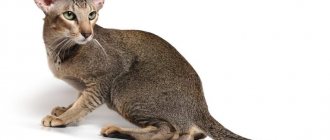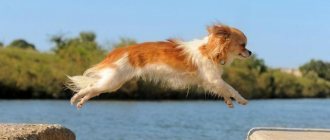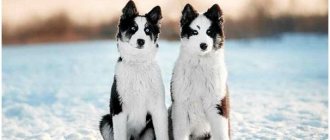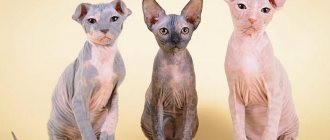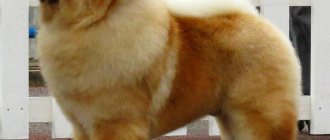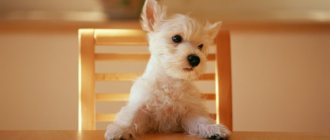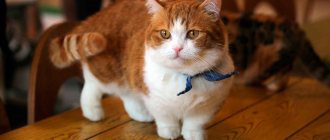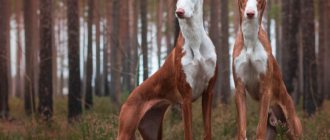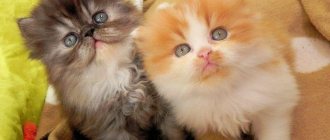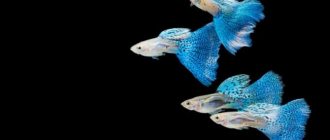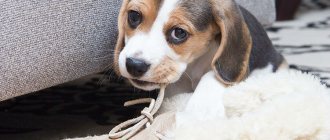Home » Cat Breeds
The smallest cat breeds in the world differ from other felines not only in their miniature size and light weight, but also sometimes in their unique body structure and eccentric appearance.
Let's find out which cat breeds are the smallest today.
- 2 6. Bambino
- 3 5. Skookum
- 4 4. Lambkin
- 5 3. Kinkaloe
- 6 2. Dwelf
- 7 1.Skif-tay-don
- 8 Conclusion
Munchkin
The smallest cat breed does not necessarily have to have a dwarf body.
It is enough to have short legs, like a munchkin , to receive such a title.
All other body proportions correspond to an ordinary medium-sized cat.
Munchkin
Interesting fact! Due to the peculiarity of the structure of the limbs, this breed was nicknamed “dachshund cat”. These animals are indeed very similar to dwarf and rabbit dachshunds .
For a long time, they did not want to recognize this breed and believed that Munchkins were ordinary cats born with a defect.
The first documented records of the munchkin date back to 1940.
Then a description of a cat appeared, similar to an ordinary one, but with short legs.
During World War II, munchkins disappeared from sight.
But then cats with short legs were spotted in the USA and USSR, similar in description to those mentioned in the 40s.
Munchkins were first presented to the public in the early 90s of the last century, at a national cat show held in the USA.
But the breed was immediately branded, recognizing it as unviable.
After much debate, munchkins were included in the development program for new breeds.
“Dachshund cats” managed to obtain champion status only in 2003.
Despite the assurances and pessimistic views of critics, munchkins are in good health, cheerful and no different from full-fledged pets. Cats of this breed weigh up to 4 kg.
Cats are smaller and weigh from 1.8 to 3.5 kg. The shortest representative of the Machkin is a cat named Liliput from the USA, who was included in the Guinness Book of Records; his height at the withers was just over 13 cm.
The breed got its name in honor of the dwarf people who lived in the Magic Land of Oz in the book by Frank Baum.
Cornish Rex
Due to their unique appearance, Cornish Rex cats are ideal for people with avant-garde taste. They were first launched on July 21, 1950. As the kitten (later named Callibunker) grew up, he became strikingly different from his littermates with a slender body, long thin legs, huge bat ears and a tousled tail. The veterinarian identified Kallibunker as a completely unique genetic mutation.
The bodies of Cornish Rex dogs are extremely thin, giving them the appearance of fragile animals. This is just a ploy, as their hard muscles and bones make them surprisingly tough cats that often weigh much more than they appear. Their weight can reach 4.5 kg. Cornish Rex dogs are sometimes compared to hounds or greyhounds due to their athletic build and quick movements. This breed also has a tendency to arch its back when walking.
The main distinguishing feature of the Cornish Rex is their coat. They only have an undercoat, somewhat reminiscent of soft sheep's wool. One of the disadvantages of such a soft, short coat is that cats do not tolerate cold conditions well, and they also do not have sufficient protection from direct sunlight, which can lead to sunburn if they stay outside for long periods of time. So these babies are definitely homemade.
The Cornish Rex is an incredibly curious, bright, energetic breed. These are natural climbers and jumpers. They are also voracious eaters. But since the breed is active enough to burn calories quickly, gaining weight is not a problem. The Cornish Rex is an extremely social breed, sometimes called the "Velcro cat."
Cornish Rex cats are very tough. They are long-lived (15 years is the norm, but 20 years is not uncommon), the breed has virtually no hereditary or genetic health problems. The only problem this breed is prone to is hair loss, which, while not life-threatening, can be severe enough that some cats have almost no fur at all.
Bambino
The smallest cat breeds in the world can have not only short legs, but also an exotic appearance.
We are talking about the Bambino - the most exclusive and expensive breed.
When you first see a photo of a bambino, you may get the impression that this is a sphinx with a limb defect.
But this is just the result of experimental breeding work.
The first representative of the Bambino was born in 2005 as a result of crossing the Canadian Sphynx and the Munchkin. The HolyMoly Cattery nursery, which bought the kitten from the owners, decided to establish an as yet unknown breed as an experiment.
The pet was given the nickname Dityatko, which later gave the name to the breed - Bambino.
Interesting fact! The bambino has a nickname - “dwarf cat”.
Bambino
The breed received experimental status from TICA (International Cat Association) in 2006.
Bambino took from her ancestors only exclusive features - hairless skin, short legs and an elongated body.
Low-growing representatives weigh between 1.8-4 kg.
Lovers of exotic pets, including Don Sphynxes and Peterbalds , can purchase a “gnome cat” for an average of 200 thousand rubles.
Siamese and Oriental (modern type)
The oldest oriental breeds differ in color - Siamese have characteristic dark areas on the ears, muzzle, tail and lower parts of the paws.
Very slender, flexible cats with a straight profile and huge ears. They weigh little due to their dry constitution and thin bones. Genetic problems require thoughtful selection of a nursery. By nature, they are overly curious monkeys who amuse themselves with seven pranks. They deftly open doors, steal bags of goodies, managing to get anywhere. They cannot stand loneliness, constantly needing emotional contact. Siamese are talkative, sometimes capricious, not always patient, but loyal to the last hair.
Skookum
The breed of the smallest cat, despite its dwarf size, does not necessarily have to have a fragile, miniature body.
She may have strong and well-developed muscles.
This statement is true for the Skookum breed, which translated into Russian means “unbending.”
The history of Skookums begins in 1996, when the first descendants of crossed Munchkins and La Perms appeared.
Their creator is the American breeder Roy Galusha, who for a decade has been trying to breed a small breed with wavy hair.
Skookum
Even in the photo it is noticeable that representatives of Skookum have a strong body, with well-developed muscles.
Interesting fact! Because of their curly fur, Skookums are also called “dwarf la-perm.”
In 2006, TICA recognized the breed as experimental.
In Australia, Skookum has already been able to win the WNCA champion title.
The weight of dwarf fluffies varies from 2 to 4 kg.
Snow shu
White “socks” on the paws add tenderness and cuteness to the animal. A unique breed that combines the features of two types of cats: Siamese and American Shorthair.
She has a balanced character, is extremely intelligent and is easy to learn. Snowshoe can open any door in the house. The love for the owner is strong, but unobtrusive.
Thanks to her sociability, the fluffy beauty quickly gets to know anyone who enters the house. It protects its owner, licks its face and hands and knows how to warn of danger. Snowshoes have a great love for children, and they are ready to participate in games both at night and during the day.
Lambkin
Lambkin
The next breed of the smallest cat appeared as a result of crossing the Munchkin and the Selkirk Rex, from which the Lambkin originated.
Translated into Russian, the word means “lamb.”
This name fully reflects the appearance of this pet, which has curly fur, like a lamb.
The lambkin inherited short, muscular legs, an elongated body and wavy hair from its ancestors.
The body weight of this animal is in the range of 1.8-4 kg.
Since the breed is not yet recognized by any international organization and does not have a standard, any colors are acceptable.
The most common are:
- bicolor;
- smoky;
- tortoiseshell.
Lambkin fur requires regular care and combing with special combs or a furminator .
In photos and in life, even adult individuals resemble a kitten with a naive expression on its face.
They are very agile, playful and full of energy.
Lambkin is in good health, but kittens often suffer from congenital pathology - deformation of the chest or back.
This is a very rare cat that is bred directly in the USA and New Zealand.
Lambkin is already registered as experimental in TICA.
Napoleon
Napoleons are small fluffy cats with kind round eyes.
They were bred in the 70s of the 20th century by an American breeder. One day he saw a photograph of a munchkin in a magazine and decided that he also wanted to breed a new breed that would resemble munchkins and Persians at the same time. The selection work took years and was constantly on the verge of failure. The fact is that the offspring were sick, the males were not capable of normal reproduction, and the whole event cost a lot of money. Once the breeder even castrated all the cats.
Then other breeders got involved, crossed females with smooth-haired individuals, and the result was absolutely extraordinary animals. Small, with thick silky hair and round eyes, on short legs, they took all the best from their ancestors. Including the cost: the price of Napoleons is quite high.
Kinkaloe
Another breed of the smallest cat was bred by crossing the same munchkin and an American curl.
The photo immediately shows what these animals gifted their descendant, the Kinkaloo.
The new breed inherited the same short legs and elongated body from the Munchkin.
The cat got curled ears from Curls.
Interesting fact! The name of the breed comes from two English words: kink, which means “bend” and low, which means “low.”
In 1997, kinkalow was registered by the TICA Association, and since 2008 it has received experimental status.
Kinkaloe
Representatives of this breed can have different colors and any coat length.
Adult pets weigh from 1.5 to 2.5 kg.
Kinkalow kittens that are born have straight ears at first, but already in the second week of life they begin to bend.
However, not everyone in the litter is born with short legs.
Although the Kinkaloo is considered a relatively healthy breed, it has many genetic problems that can affect its offspring.
Japanese Bobtail
This breed makes excellent pets. Japanese Bobtails are valued for their short curved tails, playful nature and hyperactivity. This adorable breed originates from Japan but is famous all over the world. The Japanese Bobtail is an ancient breed, bred back in the 6th century. These cats were often used to control rodents on farms. Although the Japanese Bobtail was once considered a luxurious pet, inaccessible to ordinary people. These cute, quirky cats are relatively rare outside of their homeland.
The defining physical characteristic of the Japanese Bobtail is, of course, the “clipped” cat tail. It looks more like a rabbit than a cat. The tail of the Japanese Bobtail is usually no longer than 7 cm, covered with tufts of fur and curled or curled to one side. Just like fingerprints, no two tails of this breed are alike.
The Japanese Bobtail is a short breed, growing to a maximum of 23 cm. Cats weigh 2.7-4.5 kg. They have long and muscular bodies, high cheekbones and oval eyes. Their forelimbs are slightly shorter than their hind limbs. Japanese Bobtails have two types of coat: long and short. The coloration can be solid, two-tone or striped, but the most common are white cats with colored spots. The coat is silky smooth, easy to care for and low shedding. They have no undercoat, so their hair is not prone to tangling. It is recommended to brush the coat once a week to remove dead hairs.
Japanese Bobtails are stubborn and courageous and are not easily intimidated. These energetic animals are especially loyal with children, dogs and other cats, especially other bobtails. They remain active for most of their lives. Japanese Bobtails are sociable, friendly and very intelligent. These cats love to be the center of attention, often attracting attention with their gentle melodious voices. They almost always respond when spoken to.
The lively Japanese Bobtail loves activity and does not need external motivation to exercise. They love to snack, but their active lifestyle does not always prevent obesity, so you need to monitor your bobtail's treats and food intake to prevent it from gaining excess weight. This breed is considered healthy and disease resistant. The lifespan of Japanese Bobtails is 9-15 years.
Dwelf
The next breed of the smallest cat is the result of complex breeding work, which was bred by crossing the Munchkin, the American Curl and the Canadian Sphynx.
The result is a very cute creature with short legs, the body of a dachshund and the ears of an elf, who has practically no fur.
The breed received the name Dwelf, which is derived from two words dwarf - “dwarf” and elf - “fairytale”.
The photo cannot convey the extravagant appearance of this animal, which resembles a fairy-tale elf.
The breed originated in 2009 and today has experimental status.
In total, there are about several dozen Dwelf representatives in the world.
Dwelf
Despite their dwarf size and low weight, which does not exceed 2 kg, these cats have a very muscular and strong body.
Like all sphinxes, dwelfs are sensitive to temperature changes.
It is imperative to ensure that the pet does not become overcooled or exposed to drafts.
Once every two weeks, the Dwelf needs to be bathed using a special veterinary shampoo.
Buying a dwarf kitten
It’s hard to remain indifferent at the first glance at a touching little cat—a completely natural thought immediately arises: “And I want one like that...”.
It's impossible to remain indifferent to these little cuties.
How to decide on the breed
If you have seriously decided to engage in exhibition and breeding activities with cat minis, then such a desire is unlikely to have arisen spontaneously: you have probably already thoroughly prepared both theoretically and practically, and you do not face the difficult problem of choice - you have definitely decided on your breed. But if you just really want a small living charm to appear in your house, which will forever preserve the size and sweet disposition of the kitten, this is more complicated, and you need to weigh the pros and cons.
- Decide on your preferences - do you want a fluffy, short-haired or completely “bald” cat?
- Study the equipment - carefully read articles about the breeds you like, watch videos and photographs.
- Decide what level of animal you want to purchase: show, breed or pet class.
- Soberly weigh your financial capabilities - minis are not cheap, will you later regret the impulsive purchase?
- Discuss the purchase with family members - a pet should be a desirable acquisition for everyone, and not just for you personally.
- Find out where there are breed nurseries, find reviews about their work and pets.
- First, find specialists and consult with them - it is better to have a knowledgeable person help you in your choice.
How to choose a kitten
Nowadays it is not a problem to get the kitten you like literally from anywhere in the world - breeders and carriers will ensure delivery of the baby from home to home. But if there is such an opportunity, come for your little one yourself - you are purchasing not just a living toy, but a new family member, and personal contact in this case is very important. At the same time, get to know the breeder better, look at the kitten’s parents and the conditions in which they are kept.
When choosing a kitten, meet its mother
Do not hesitate to ask questions to the breeder - it is better to prepare a list of them in advance. Ask, among other things, about the health of your baby's parents, as well as kittens from previous litters, and whether they have had genetic tests. Draw up a contract for the purchase of a kitten - a responsible breeder will never refuse such a step.
Of course, neither all these measures nor a thorough examination of the baby guarantees that you are purchasing a healthy animal that fully meets the requirements of the breed standard. But you will know that you did everything you could for this - and may luck be with you and with the little tailed miracle that will enter your home!
Maybe this baby is waiting for you?
1.Skif-tay-don
A very rare breed of the smallest cat in the world appeared in 1988, thanks to a selection experiment by breeder Elena Krasnichenko, who was breeding Thai and Kuril bobtails .
A non-standard Old Siamese-type cat with a kink in its tail came into her cattery, and then a Thai cat with a tail resembling a donut.
As a result of crossing this unusual pair, a tiny kitten with a short tail was born.
The representative of the future new breed was named Kutsy.
Skif-tay-don
In 2009, the breed was registered with TICA as an experimental breed.
Skif-tay-don has a miniature size and looks like a four-month-old kitten.
Pets of this breed weigh no more than 2 kg.
Origin of dwarf cat breeds
If in cynology decorative dog breeds are thoroughly balanced by service, hunting and numerous companion dogs, then felinology has been developing exclusively in the direction of decorativeness for a long time. No, really, an elite purebred cat from a good home will not hone its working skills in catching mice and rats - where can I get them, in a good home? An exclusive bright appearance is much more valuable, and all the efforts of breeders are aimed at improving it.
Decorative dwarf cat breeds are becoming increasingly popular in the world
In the last twenty to thirty years, a new trend has emerged - the breeding of cute, touching and funny dwarf cats, which until old age remain eternal kittens both in appearance and in behavior. Fashion determined demand, demand gave birth to supply - breeders in Europe and America began to develop new breeds according to a single principle: the smaller and funnier the cat, the better.
There have been many attempts, but not all of them were successful - now we can name up to one and a half dozen more or less mature young breeds of baby cats, and most of them are of American origin. Almost all of them are the result of either gene mutation or hybridization; only, perhaps, the Singapore cat can be classified as a native breed.
The Singapore cat is the only native dwarf breed
Rare dwarf breeds still have many disadvantages, the main ones of which are:
- instability;
- limited gene pool;
- lack of knowledge of hereditary pathologies.
Video: Lilliputians of the cat world
fun lover
Such a cat is tireless in games, she is ready to jump for a long time. She is very devoted to her owner and follows on his heels. She has absolutely no aggression and accepts all manifestations of love from her owners with gratitude. Singapuras are quite smart and will not bother you if the owners are not in the mood for games and entertainment. However, as soon as the opportunity arises, they are able to spend a lot of time playing with people, children and other animals. Other oriental cats are talkative, but not the Singapura - they “talk” little, and their voice is gentle and quiet. This cat is the best pet in a family with children, because she is completely gentle and loves to play.
Despite the apparent fragility of these animals, they are full of energy, and their size does not in any way affect their health. They are perky and full of ideas. Dwarf cats of this breed take longer to develop than other representatives of the eastern group. There are few kittens in a litter, usually no more than three or four. At the age of four months, babies become ready to leave their mother.
The Singapura is perhaps one of the rarest breeds; in Russia there are very few nurseries breeding these cats. And in other countries there are an order of magnitude less of them than other species. The Singapura cat is an ideal pet for those who love active games with animals and appreciate their pleasant disposition, quiet voice and unobtrusiveness.
Miniature stature
Born in 1990 in the United States, the Himalayan-Persian kitten Tinker Toy is distinguished by his miniature stature. Immediately after birth, the kitten did not stand out from its littermates. Over time, it became clear that the baby retained its size without changing. The owners are Scott and Katrina Forbes from Illinois. The length of the body without a tail of this cat, upon reaching two and a half years, was equal to eighteen centimeters, and the weight of the tiny animal did not exceed 700 grams. Tinker Toy was uniquely small in height - 7 centimeters.
In photographs of the owners, Tinker Toy is captured with a Pepsi can, which towers over the cat. When he reached six years old, the cat died.
Mr. Pibbles - the smallest cat
One of the contenders for the title of the smallest cat is the well-known Mr. Pibbles, who lives in Beijing, not in China, but in the state of Illinois (USA). This name was given to him by his first owner, Robin Svendson. It was named after one of the characters from the Seinfeld series - the ventriloquist doll. But since his owner did not like his too small pet, he decided to find him another owner. One day, Dr. Donna Sussman, who works at a veterinary clinic, appeared at his house and came to Robin to vaccinate his dog. It was then that she saw a little kitten who won her heart. Donna asked the owner if she could take him with her, to which he replied that she could if she could catch him. No one then had any idea that this kitten would decorate collections of photos of the smallest cats.
Singapura cats are the smallest cats in the world.
Donna turned out to be quick enough and took the kitten with her to the veterinary clinic, where he has lived ever since. But after some time it became clear that the kitten was not going to grow. Then the veterinarians conducted a thorough examination, the result of which was that Mr. Pibbles was in fact not a kitten at all, but a fully formed and, quite surprisingly, healthy cat. It was then that it became clear that the world’s smallest cats had found another brother. The cat's miniature size is the result of some genetic changes, which caused the growth to stop. At two years old, Mr. Pibbles was fifteen centimeters long, not counting his tail, and weighed only 1300 grams. Then the clinic staff decided to contact the records committee, and in 2004 their pet was registered as the smallest cat in the world.
As his “main” owner Donna Sussman says, the cat has a very affectionate character and he prefers to sleep with her, clinging to her neck. Moreover, he tries to take a place between her and her husband. Interestingly, Mr. Pibbles has a very good appetite - in order not to lose weight, he needs to eat at least four times a day (two meals a day is enough for an ordinary cat). The mini-cat became especially famous after a photograph of him was posted online, showing him sitting in a glass.
